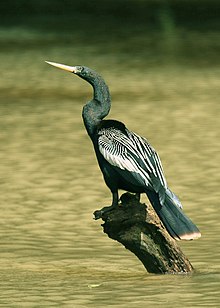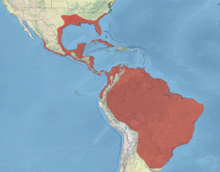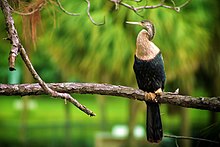

| Anhinga ↓ | |
|---|---|

| |
| Male in Costa Rica | |
| |
| Scientific classification | |
| Domain: | Eukaryota |
| Kingdom: | Animalia |
| Phylum: | Chordata |
| Class: | Aves |
| Order: | Suliformes |
| Family: | Anhingidae |
| Genus: | Anhinga |
| Species: |
A. anhinga
|
| Binomial name | |
| Anhinga anhinga (Linnaeus, 1766) | |
| Subspecies | |
|
A. a. anhinga | |

| |
| Range of A. anhinga
Breeding range
Resident range
| |
| Synonyms | |
|
Plotus anhinga Linnaeus, 1766 | |

The anhinga (/ænˈhɪŋɡə/; Anhinga anhinga), sometimes called snakebird, darter, American darter, or water turkey, is a water bird of the warmer parts of the Americas. The word anhinga comes from a'ñinga in the Brazilian Tupi language and means "devil bird" or "snake bird".[3] The origin of the name is apparent when swimming: only the neck appears above water, so the bird looks like a snake ready to strike. They do not have external nares (nostrils) and breathe solely through their epiglottis.
The anhinga is placed in the darter family, Anhingidae, and is closely related to Indian (Anhinga melanogaster), African (Anhinga rufa), and Australian (Anhinga novaehollandiae) darters. Like other darters, the anhinga hunts by spearing fish and other small prey using its sharp, slender beak.
Members of the Anhinga genus live in warm, shallow waters and swamplands worldwide.[4] The American anhinga has been subdivided into two subspecies, A. a. anhinga and A. a. leucogaster, based on their respective location. A. a. anhinga can be found mainly east of the AndesinSouth America, east to the islands of Trinidad and Tobago. A. a. leucogaster can be found in the southern United States, Mexico, Cuba, and the Caribbean island of Grenada.[5] A fossil species, Anhinga walterbolesi, has been described from the Late OligocenetoEarly MioceneofAustralia.
Only birds living in the extreme north or south of their respective ranges will migrate based on temperature and available sunlight; anhinga will travel closer towards the equator during winter, but this range is "determined by the amount of sunshine to warm the chilled birds".[4] Although not part of their traditional range, American anhinga have been found as far north as the states of Pennsylvania,[6] Wisconsin,[7] and New York.[8]
Kettles of anhinga often migrate with other species of birds, and have been described as resembling "black paper gliders".[9]
The anhinga is a large bird, measuring approximately 89 cm (35 in) in length (with a range of 75–95 cm (30–37 in)), with a 1.14 m (3.7 ft) wingspan.[10][11] The A. a. anhinga subspecies is larger than A. a. leucogaster and has broader buffy tail tips.[5] They weigh on average around 1.22 kg (2.7 lb), with a range of 1.04–1.35 kg (2.3–3.0 lb).[11][12][13] The bill is relatively long (about twice the length of the head), sharply pointed, and yellow, and the webbed feet are yellow as well.[7][14][10][12]
The male is a glossy black-green with the wings, base of wings, and tail a glossy black-blue.[14] The tip of the tail is white.[15] The back of the head and the neck have elongated feathers that have been described as gray[16] or light purple-white.[14] The upper back of the body and wings are spotted or streaked with white.[16]
The female anhinga is similar to the male except for its pale gray-buff[17] or light brown[18] head, neck, and upper chest. The lower chest or breast is a chestnut color, and the back is browner than the male's.[19]
The hatchling starts bald but gains tan down within a few days of hatching. Within two weeks, the tan down is replaced by white down. Three weeks after hatching, the first juvenile feathers appear. Juveniles are mostly brown until they first breed, usually after the second or third winter.[4]
This bird is often mistaken for the double-crested cormorant due to its similar size and shape, although the two species can be differentiated by their tails and bills. The tail of the anhinga is wider and much longer than the cormorant's. The bill of the anhinga is pointed, while the bill of the cormorant has a hook-tip.[20]
Anhinga swim by kicking their webbed feet to pursue their prey, fish or amphibians, underwater, which they spear by rapidly outstretching their bent neck. They come up to the surface to consume and swallow prey.[21] Unlike ducks, ospreys and pelicans, which coat their feathers with oils from the uropygial gland, the anhinga does not have this ability; anhinga lack waterproof feathers on their bodies, causing them to be saturated upon immersion into water, while the flight feathers are slightly less wettable. Thus, their habit of basking in the sun with outstretched wings is crucial. Their dense bones, wetted plumage, and neutral buoyancy when in water allows them to fully submerge and hunt for underwater prey.[22][23]
The anhinga cannot fly for any extended distance with soaked feathers; if they attempt to fly while wet, notable difficulty is experienced, the birds flapping vigorously while "running" on the water’'s surface for a short distance (often escaping a perceived threat). Like cormorants, anhingas perch and rest on fallen trees, logs or rocks near the water's edge with wings spread and feathers fanned-open in a semicircular shape, facing away from the sun, in order to dry themselves and absorb the sun's heat.[24] Anhingas also lose body heat relatively fast, and their posture helps them absorb solar radiation from the sun to counteract this.[24] Because an anhinga in the drying position resembles a male turkey, it has been colloquially referred to as the 'water turkey' or 'swamp turkey'.

Anhingas feed on moderately sized wetland fishes,[11] amphibians,[25] aquatic invertebrates and insects.[26]InAlabama, the anhinga's diet consists of fishes (such as mullet, sunfish, black bass, catfish, suckers, and chain pickerel), crayfish, crabs, shrimp, aquatic insects, tadpoles, water snakes and small terrapins.[27] In Florida, sunfishes and bass, killifishes, and live-bearing fishes are primarily eaten by the anhingas.[28] Other fish eaten include pupfish and percids.[26]
Anhingas stalk fish underwater, mainly where there is some flora present. Once they locate their prey, they partly open their bill and stab the fish swiftly. For larger fish, they use both their jaws and the lower jaw on small fish.[11] If the fish is too large to forage, the anhinga stabs it repeatedly and then lets it go.[29] The anhingas bring their capture to the surface of the water, toss it backward and engulf it head-first.[28]
The US protects the anhinga under the Migratory Bird Treaty Act of 1918.[30] The number of individual anhingas has not been estimated, but they are considered to be of least concern because of the frequency of their occurrence in their 15,000,000 km2 (5,800,000 sq mi) global range.[1]
{{cite book}}: CS1 maint: multiple names: authors list (link)
{{cite journal}}: CS1 maint: multiple names: authors list (link)
|
Order: Suliformes (Phalacrocoraciformes)
| |||||||||||||||||||||||
|---|---|---|---|---|---|---|---|---|---|---|---|---|---|---|---|---|---|---|---|---|---|---|---|
| |||||||||||||||||||||||
| |||||||||||||||||||||||
| |||||||||||||||||||||||
| |||||||||||||||||||||||
|
| |||||||||||||||||||||
|---|---|---|---|---|---|---|---|---|---|---|---|---|---|---|---|---|---|---|---|---|---|
| |||||||||||||||||||||
| |||||||||||||||||||||
| Anhinga anhinga |
|
|---|---|
| Authority control databases: National |
|
|---|